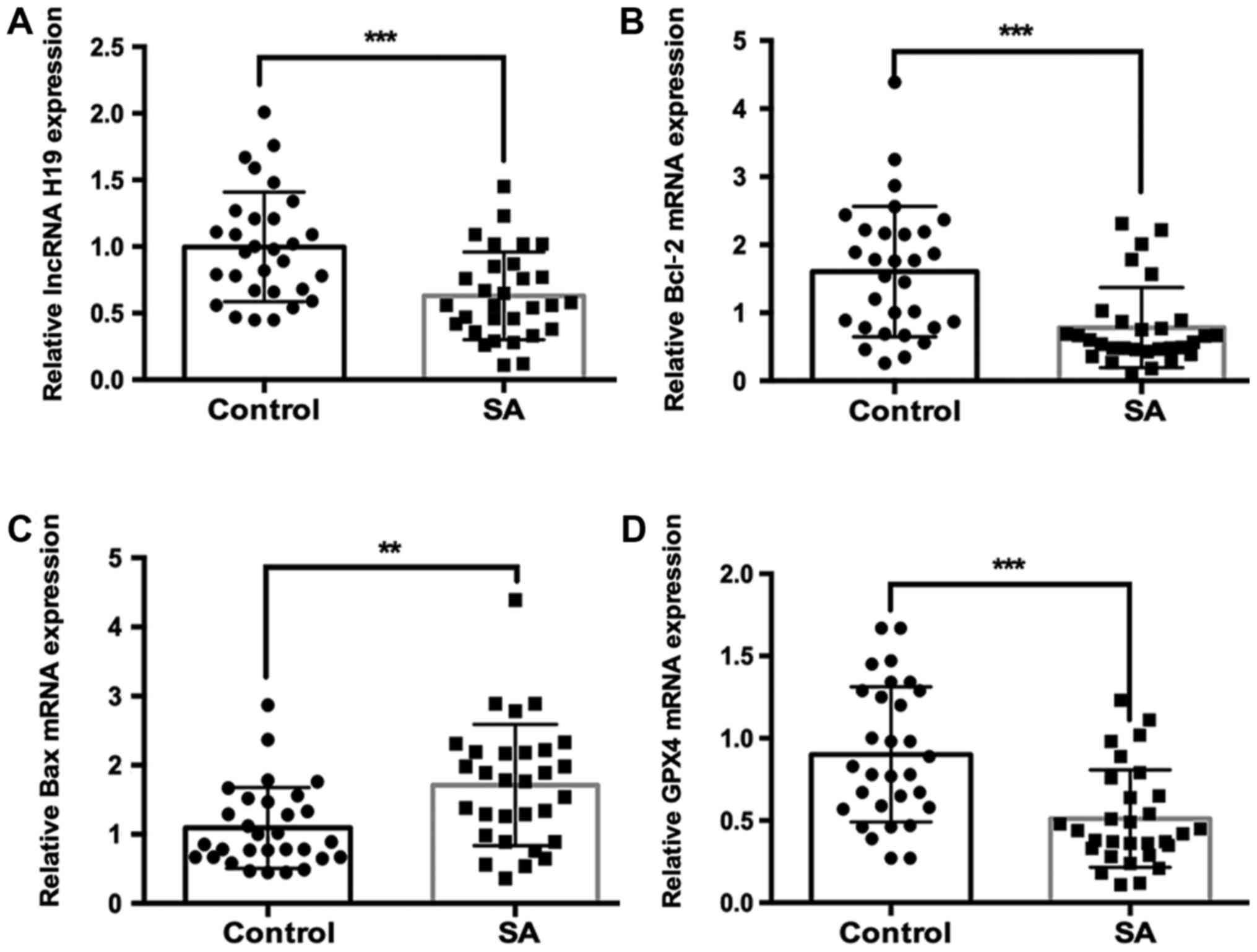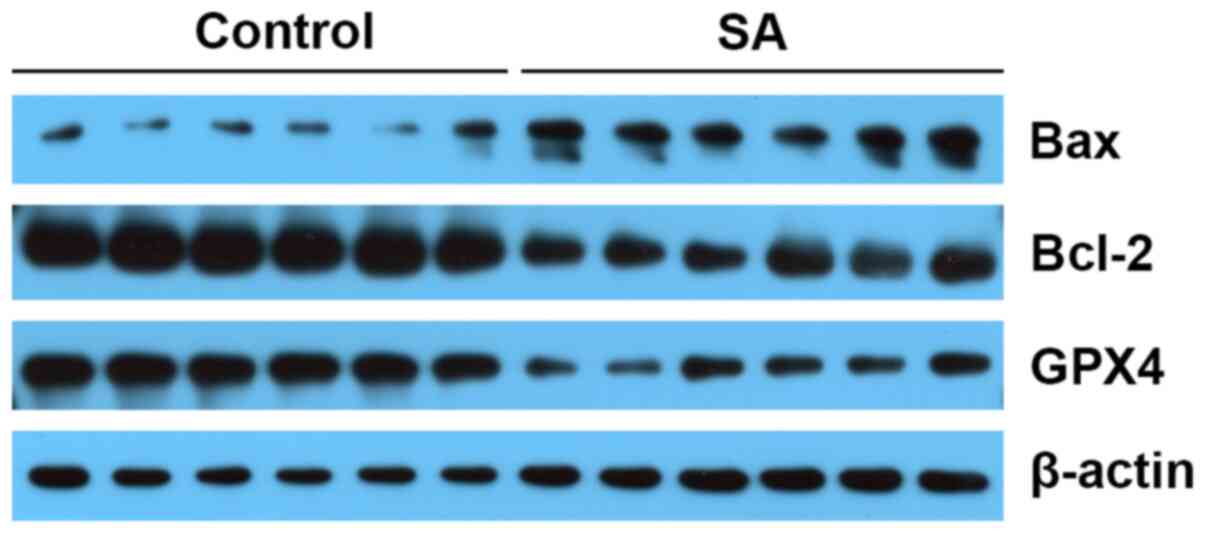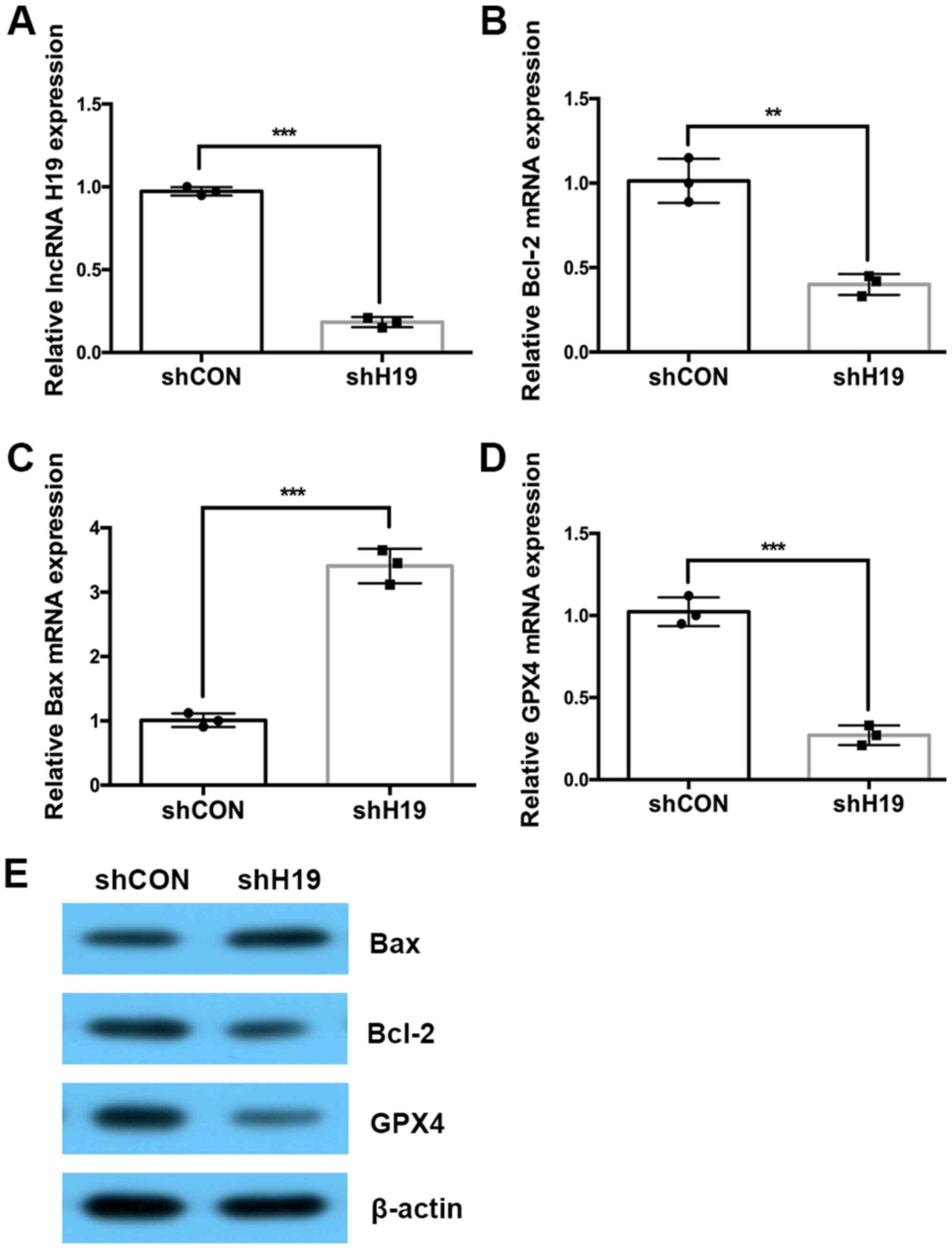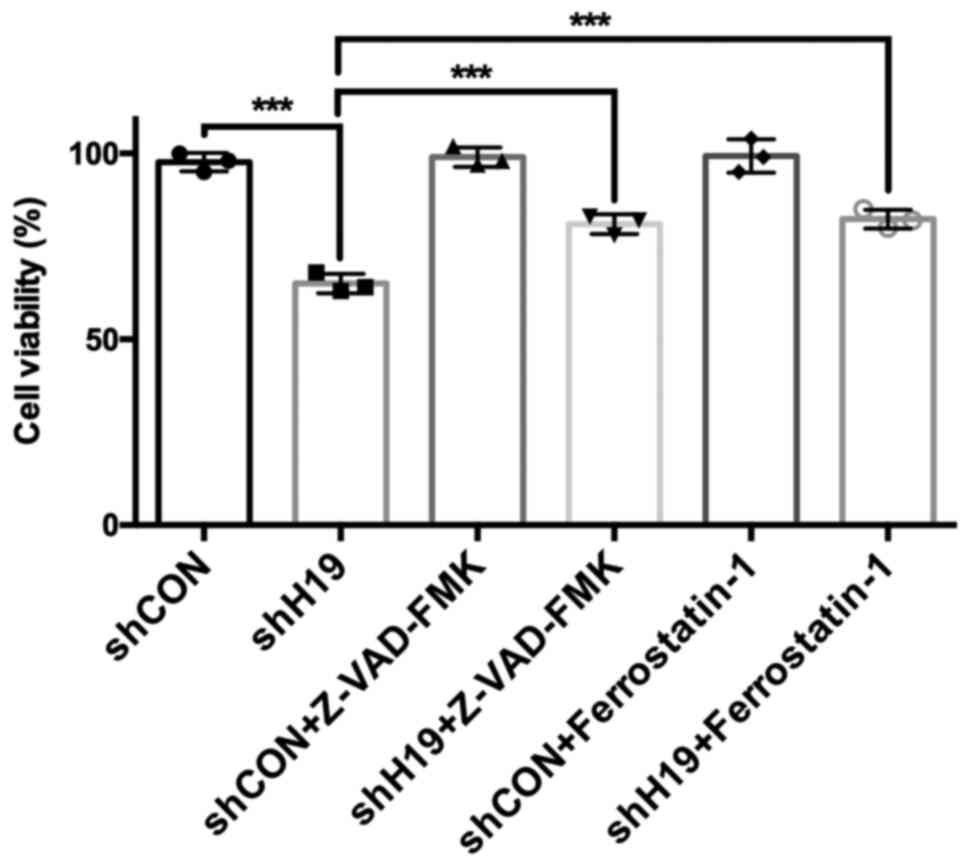Long non‑coding RNA H19 regulates Bcl‑2, Bax and phospholipid hydroperoxide glutathione peroxidase expression in spontaneous abortion
- Authors:
- Published online on: November 17, 2020 https://doi.org/10.3892/etm.2020.9473
- Article Number: 41
Abstract
Introduction
The incidence of spontaneous abortion (SA) is 10-15% in clinical pregnancies globally (1). The definition of SA is clinically confirmed pregnancy loss within 24 weeks of pregnancy (2,3). The etiology of pregnancy loss is complicated, and genetic factors such as chromosomal abnormalities and single gene disorders, endocrinological factors such as diabetes mellitus and thyroid disease, environmental factors such as alcohol and tobacco and infectious factors such as viral and bacterial factors are all the risk factors of SA (4,5). However, there may still be other unknown factors contributing to SA, therefore further investigation is needed.
The cellular mechanisms underlying recurrent abortion are the proliferation and apoptosis of cytotrophoblasts and human decidual cells (6). Zhang et al (7) reported that microRNA (miR)-184 is highly expressed in decidual stromal cells, decidual immune cells and peripheral blood of patients who experience recurrent spontaneous abortion (RSA). Mechanically, miR-184 promotes apoptosis and inhibits the proliferation of trophoblast cells by targeting and regulating WIG1(7). miR-520 also enhances the apoptosis of trophoblast cells by targeting poly (ADP-ribose) polymerase (PARP)1 in human-trophoblast-derived HTR-8/SVneo cells (8). Ferroptosis is form of programed cell death that is different from apoptosis both in morphology and biochemical levels such as caspase-3 activation, and is characterized by the accumulation of reactive oxygen species (ROS) as a result of iron accumulation and lipid peroxidation (9). Ferroptosis is involved in several diseases, such as ischemia/reperfusion-induced organ injury, stroke and cancer, and ferroptosis inhibition is effective in treating ischemia/reperfusion-induced organ injury and stroke in a number of experimental models in vivo (10-12). However, whether ferroptosis is involved in the process of SA is still unknown.
Long non-coding RNAs (lncRNAs), which are >200 nucleotides in length, have important roles in a number of cellular processes, including posttranslational regulation and carcinogenesis (13,14). H19 is a lncRNA that is 2.3 kb long and is primarily located in cytoplasm. During embryonic development, H19 is highly expressed; however, after birth, the expression of H19 is decreased (15). Most studies investigating H19 have focused on its role in carcinogenesis, including tumor growth and metastasis (16,17), and although several studies have analyzed the expression and methylation status of H19 in SA (18,19), whether H19 regulates apoptosis and ferroptosis in SA is unknown.
The present study analyzed the expression levels of H19 and the apoptosis- and ferroptosis-associated genes Bcl-2, Bax and phospholipid hydroperoxide glutathione peroxidase (GPX4) in SA tissues. Importantly, the current study also further evaluated the regulatory correlations between H19 and Bcl/GPX4/Bax both at the mRNA and protein levels.
Materials and methods
Patient sample collection
The placental villi tissues from patients with SA (SA group) and clinically normal pregnancies terminated for non-medical reasons (control group) were collected. The SA group consisted of 30 women aged 21-38 years. The criteria for inclusion in SA group were as follows: i) Normal chromosome number and structure of both the mother and father, ii) no thyroid dysfunction, diabetes and other systemic diseases, iii) no reproductive endocrine disease, iv) no deformity of genital tract and uterus and v) the activity and quality of sperm of the father were normal. The control group included 30 women aged 21-38 years who requested termination due to an unplanned pregnancy. The criteria for control group were as follows: i) No vaginal bleeding, ii) no abdominal pain. All women in these two groups were between gestational weeks six to nine. The present study was approved by The Medical Ethics Committee of the First People's Hospital of Yunnan Province (approval no. 2018-012, Kunming, China) and written informed consent was provided by each patient.
Cell culture
HTR-8/SVneo cells (henceforth referred to as HTR-8) were purchased from the American Type Culture Collection and cultured in RPMI-1640 medium (Gibco; Thermo Fisher Scientific, Inc.) supplemented with 10% fetal bovine serum (Gibco; Thermo Fisher Scientific, Inc.), 100 U/ml penicillin and 100 µg/ml in CO2 at 37˚C.
Cell transfection
A H19 knockdown lentiviral vector (pGLVU6-puro-H19-shRNA) and negative vector (non-targeting control, pGLVU6-puro-NC-shRNA) were constructed by Shanghai GenePharma Co., Ltd. 3 µg H19 knockdown lentiviral vector/negative vector were co-transfected with 2.5 µg pMD2.G and 7.5 µg psPAX2 plasmids into 293T cells (75 cm2 flasks) for lentivirus packaging with Lipofectamine 2000 reagent (Thermo Fisher Scientific, Inc.). The sequences are as follows: H19 short hairpin (sh)RNA, 5'-CCGGCAGCCTTCAAGCATTCCATTACTCGAGTTTTTG-3'; NC shRNA, 5'-CCGGTTCTCCGAACGTGTCACGTTTTTTG-3'. Lentivirus infection was applied to HTR-8 cells with 50-60% confluence. Reverse transcription-quantitative (RT-q)PCR was used to examine the efficiency of H19 knockdown after 72 h of infection.
RT-qPCR
TRIzol® reagent (Invitrogen; Thermo Fisher Scientific, Inc.) was used to isolate total RNA of tissues and cells according to the protocol of the manufacturer. A QuantiTect Reverse Transcription kit (Qiagen China Co., Ltd.) was used to synthesize cDNA by incubating at 42˚C for 15 min. H19, Bcl-2, Bax and GPX4 levels were detected by using a SYBR Green RT-qPCR assay kit (Takara Biotechnology Co., Ltd.), and GAPDH was used as the endogenous control. The PCR program was as follows: Stage 1, 95˚C for 30 sec; stage 2, 95˚C for 5 sec and 60˚C for 34 sec, for 40 cycles. The primer sequences were as follows: Bcl-2, forward, 5'-GGTGGGGTCATGTGTGTGG-3' and reverse, 5'-CGGTTCAGGTACTCAGTCATCC-3'; Bax, forward, 5'-CCCGAGAGGTCTTTTTCCGAG-3' and reverse, 5'-CCAGCCCATGATGGTTCTGAT-3'; GPX4, forward, 5'-GAGGCAAGACCGAAGTAAACTAC-3' and reverse, 5'-CCGAACTGGTTACACGGGAA-3'; H19, forward, 5'-CGTGACAAGCAGGACATGACA-3' and reverse, 5'-CCATAGTGTGCCGACTCCG-3'; GAPDH, forward, 5'-GGAGCGAGATCCCTCCAAAAT-3' and reverse, 5'-GGCTGTTGTCATACTTCTCATGG-3'. Quantitative measurements were evaluated using the 2-ΔΔCq method (20). The mRNA levels of H19, Bcl-2, Bax and GPX4 in shCON group were normalized to 1.
Western blotting
HTR-8 cells were collected and lysed using RIPA lysis buffer (Beyotime Institute of Biotechnology) for 25 min on ice. Protein concentrations were evaluated using the BCA method. Equal amounts of proteins (7-10 µg per sample) were loaded per lane on a 12% gel, resolved using SDS-PAGE and subsequently transferred to PVDF membranes. Then the membranes were blocked with 5% non-fat milk for 1 h at the room temperature. The membranes were treated with primary antibodies overnight at 4˚C. Next, the membranes were treated with the secondary antibodies for 1 h at room temperature. The protein signals were detected using ECL Detection Reagent (Beijing Solarbio Science & Technology Co., Ltd.). The primary antibodies including anti-Bcl-2 (1:1,000; cat. no. 15071), anti-Bax (1:1,000; cat. no. 5023) and anti-β-actin (1:5,000; cat. no. 3700) antibodies were purchased from Cell Signaling Technology, Inc., and anti-GPX4 (1:1,000; cat. no. ab125066) was purchased from Abcam. The secondary antibodies including anti-mouse IgG, HRP-linked antibody (1:3,000; cat. no. 7076) and anti-rabbit IgG, HRP-linked antibody (1:3,000; cat. no. 7074) were purchased from Cell Signaling Technology, Inc. β-actin was used as the internal control.
Cell viability analysis
After H19 shRNA infection for 48 h, HTR-8 cells were seeded in 96-well plates. The cells were then divided into six groups, the shCON, shH19, shCON+Z-VAD-FMK, shH19+Z-VAD-FMK, shCON+Ferrostatin-1 and the shH19+Ferrostatin-1 group. After treatment for 48 h, cell viability was examined by using the Cell Counting Kit-8 method as previously described (21). Z-VAD-FMK (Selleck Chemicals) was a strong apoptosis inhibitor, and ferrostatin-1 (Selleck Chemicals) was a ferroptosis inhibitor which could depress the cellular lipid peroxidation (22).
Statistical analysis
Data are presented as the mean ± standard deviation. Statistical analysis was performed using SPSS version 19.0 software (IBM, Corp.). Data were analyzed using a two-tailed unpaired Student's t-test (two groups) or analysis of variance (ANOVA) with Tukey's post hoc test for multiple comparisons. The correlation between Bax, Bcl-2 and GPX4 mRNA expression with H19 levels was analyzed using Pearson's correlation. P<0.05 was considered to indicate a statistically significant difference. All in vitro experiments were repeated in triplicate.
Results
Expression levels of H19 and apoptosis- and ferroptosis-associated genes in the SA group
Sixty patients were included in the present study, including 30 cases in the SA group and 30 cases in the control group. RT-qPCR was used to detect the RNA expression levels of H19, Bcl-2, Bax and GPX4. The results showed that the RNA expression levels of H19 were significantly lower in SA group compared with those in the control group (Fig. 1A). It was further found that the mRNA expression of anti-apoptosis gene Bcl-2 was significantly lower, and the mRNA expression of proapoptotic gene Bax was significantly higher in SA group compared with those in control group (Fig. 1B and C). Notably, the ferroptosis-associated gene GPX4 was also significantly downregulated in SA group compared with the control group (Fig. 1D).
Correlation analysis was applied to evaluate relationship between the RNA expression levels of H19 and apoptosis- and ferroptosis-associated genes. lncRNA H19 expression was significantly positively correlated with Bcl-2 expression (R=0.4730, P=0.0083), and significantly negatively correlated with Bax expression (R=-0.3714, P=0.0433; Fig. 2A and B). Notably, it was also demonstrated that H19 expression was significantly positively correlated with GPX4 expression (R=0.6450, P=0.0001; Fig. 2C).
Western blotting was used to evaluate the expression of apoptosis- and ferroptosis-associated proteins. The protein levels of Bax were higher in SA group, and Bcl-2 levels were lower in SA group compared those in the control group. In addition, GPX4 expression was downregulated in SA group compared with the control group (Fig. 3).
Silencing H19 downregulates Bcl-2 and GPX4 and upregulates Bax in HTR-8 cells
HTR-8 cells were transfected with the shH19 lentiviral construct, and the results showed that the expression of H19 was significantly decreased by ~80% (Fig. 4A). Then, the expressions of Bcl-2, Bax and GPX4 were evaluated using RT-qPCR and western blotting. The results showed that silencing H19 significantly reduced expression of Bcl-2 and GPX4 and increased Bax expression at both the mRNA and protein levels (Fig. 4B-E).
The viability of HTR-8 cells following H19 knockdown and apoptosis or ferroptosis inhibitor treatment was further examined. The results showed that H19 silencing significantly reduced the viability of HTR-8 cells, and Z-VAD-FMK (an apoptosis inhibitor) and Ferrostatin-1 (a ferroptosis inhibitor) (22) could partially rescue the decreased viability of HTR-8 cells induced by H19 knockdown (Fig. 5).
Discussion
SA is the most frequently occurring pregnancy disorder and is a serious threat to women's health (23). SA has been reported to be associated with several risk factors, including endocrine disorders, anatomic deformation, immunodeficiency and chromosomal abnormalities (24-27). However, other risk factors and underlying molecular mechanisms of SA still need further investigation.
H19, a lncRNA, is involved in the pathogenesis of several diseases, including lung cancer and pre-eclampsia (28,29). Although a previous study reported that the methylation of H19 differentially methylated regions is increased in the placental samples of SA cases (23), the role and underlying mechanism of H19 in SA are still largely unclear. The present study revealed that the expression of H19 was lower in SA group compared with that in control group.
Trophoblast cells participate in the formation of placenta and have important functions in embryo implantation (30). Apoptosis of trophoblast cells is involved in SA (31). The apoptotic rate and mRNA and protein expression of Fas and FasL were significantly higher in recurrent spontaneous abortion compared with the abortion group (32). Li et al (33) reported that knockdown of Storkhead-box protein 1 induced apoptosis and decreased the migration and proliferation of HTR-8/SVneo cells via mediating the PI3K/AKT signaling pathway (33). A previous study also reported that miR-184, which is highly expressed in RSA, repressed the proliferation and promoted the apoptosis of trophoblast cells by targeting WIG1 and upregulating its downstream molecule Fas (7). Dong et al (8) also found that miR-520, which is highly expressed in villi in RSA, enhanced the apoptosis of human trophoblast cells by targeting and regulating PARP1 expression. Increased cyclin-dependent kinase inhibitor 1 and Bax expression was associated with increased apoptosis of cytotrophoblasts and human decidual cells in the RSA group (34). However, the regulatory mechanisms underlying trophoblast apoptosis are still largely unknown. The present results demonstrated that the mRNA and protein expression of Bcl-2 was lower and the expression of Bax was higher in SA compared with control tissues. Notably, the expression of Bcl-2 was positively correlated with H19 expression, and Bax expression was negatively correlated with H19 levels. In vitro analysis revealed that silencing H19 decreased Bcl-2 and upregulated Bax expression at both the mRNA and protein levels.
Ferroptosis is a caspase-independent, non-apoptotic and newly defined type of cell death characterized by high levels of lipid peroxidation (35). GPX4 is the key regulator of ferroptosis by controlling the activity of cyclooxygenase and lipid-modulating lipoxygenase enzymes (36). A recent study has reported that an inactivating mutation of GPX4 has a dominant-negative effect on male fertility (36). However, the roles of ferroptosis and GPX4 in SA are still unknown. The present findings reported that GPX4 expression was lower in SA group compared with that in control group and was positively correlated with H19 expression. In addition, silencing H19 downregulated GPX4 expression levels. Overall, these results indicated that ferroptosis was involved in SA.
The mechanisms by which lncRNA H19 regulates Bcl-2, Bax and GPX4 expression is still unclear. A previous study reported that H19 could directly binds to the miR-17-92 cluster and suppress STAT3 activity, decreasing the expression of its target genes Bcl-2 and Bcl-2L1 (37). H19 is also reported to positively regulate Bcl-2 expression by sponging miR-877-3p in myocardial ischemia/reperfusion injury (I/RI) (38). Whether H19 regulates Bcl-2 by these two pathways or other pathways in SA still needs to be explored.
There are some limitations to the present study. Firstly, the regulatory association between H19 and Bcl-2, Bax and GPX4 was confirmed in only one cell line. In the future, more cell lines should be used to verify the present findings. Secondly, an Annexin V/PI and lipid peroxidation assays should be used in the figure to investigate the regulatory association between H19 and apoptosis and ferroptosis.
Overall, the present study demonstrated that H19 was downregulated in SA cases, and H19 expression was positively correlated with Bcl-2 and GPX4 levels, and negatively correlated with Bax expression. In addition, silencing H19 downregulated Bcl-2 and GPX4, and upregulated Bax at both the mRNA and protein levels. The results of the current study may provide a novel insight for the pathogenesis for SA.
Acknowledgements
Not applicable.
Funding
The present study was funded by The Open Project Program of Yunnan Provincial Key Laboratory for Birth Defects and Genetic Diseases (grant no. 2017ZDKFKT001).
Availability of data and materials
All data generated or analyzed during this study are included in this published article.
Authors' contributions
RXB and ZYT designed the study. RXB and ZYT performed the experiments. ZYT wrote the paper. All authors read and approved the final manuscript.
Ethics approval and consent to participate
The present study was approved by The Medical Ethics Committee of the First People's Hospital of Yunnan Province (approval no. 2018-012, Kunming, China) and written informed consent was provided by each patient.
Patient consent for publication
Not applicable.
Competing interests
The authors declare that they have no competing interests.
References
|
Van Den Berg MM, Van Maarie MC, Van Wely M and Goddijn M: Genetics of early miscarriage. Biochim Biophys Acta. 1822:1951–1959. 2012.PubMed/NCBI View Article : Google Scholar | |
|
Tur-Torres MH, Garrido-Gimenez C and Alijotas-Reig J: Genetics of recurrent miscarriage and fetal loss. Best Pract Res Clin Obstet Gynaecol. 42:11–25. 2017.PubMed/NCBI View Article : Google Scholar | |
|
Regan L and Rai R: Epidemiology and the medical causes of miscarriage. Baillieres Best Pract Res Clin Obstet Gynaecol. 14:839–854. 2000.PubMed/NCBI View Article : Google Scholar | |
|
Christiansen OB, Steffensen R, Nielsen HS and Varming K: Multifactorial etiology of recurrent miscarriage and its scientific and clinical implications. Gynecol Obstet Invest. 66:257–267. 2008.PubMed/NCBI View Article : Google Scholar | |
|
Warren JE and Silver RM: Genetics of pregnancy loss. Clin Obstet Gynecol. 51:84–95. 2008.PubMed/NCBI View Article : Google Scholar | |
|
Cinar O, Kara F and Can A: Potential role of decidual apoptosis in the pathogenesis of miscarriages. Gynecol Endocrinol. 28:382–385. 2012.PubMed/NCBI View Article : Google Scholar | |
|
Zhang Y, Zhou J, Li MQ, Xu J, Zhang JP and Jin LP: MicroRNA-184 promotes apoptosis of trophoblast cells via targeting WIG1 and induces early spontaneous abortion. Cell Death Dis. 10(223)2019.PubMed/NCBI View Article : Google Scholar | |
|
Dong X, Yang L and Wang H: miR-520 promotes DNA-damage-induced trophoblast cell apoptosis by targeting PARP1 in recurrent spontaneous abortion (RSA). Gynecol Endocrinol. 33:274–278. 2017.PubMed/NCBI View Article : Google Scholar | |
|
Dixon SJ, Lemberg KM, Lamprecht MR, Skouta R, Zaitsev EM, Gleason CE, Patel DN, Bauer AJ, Cantley AM, Yang WS, et al: Ferroptosis: An iron-dependent form of nonapoptotic cell death. Cell. 149:1060–1072. 2012.PubMed/NCBI View Article : Google Scholar | |
|
Friedmann Angeli JP, Schneider M, Proneth B, Tyurina YY, Tyurin VA, Hammond VJ, Herbach N, Aichler M, Walch A, Eggenhofer E, et al: Inactivation of the ferroptosis regulator Gpx4 triggers acute renal failure in mice. Nat Cell Biol. 16:1180–1191. 2014.PubMed/NCBI View Article : Google Scholar | |
|
Linkermann A, Skouta R, Himmerkus N, Mulay SR, Dewitz C, De Zen F, Prokai A, Zuchtriegel G, Krombach F, Welz PS, et al: Synchronized renal tubular cell death involves ferroptosis. Proc Natl Acad Sci USA. 111:16836–16841. 2014.PubMed/NCBI View Article : Google Scholar | |
|
Alim I, Caulfield JT, Chen Y, Swarup V, Geschwind DH, Ivanova E, Seravalli J, Ai Y, Sansing LH, Ste Marie EJ, et al: Selenium drives a transcriptional adaptive program to block ferroptosis and treat stroke. Cell. 177:1262–1279, e1225. 2019.PubMed/NCBI View Article : Google Scholar | |
|
Cheng G, Song Z, Liu Y, Xiao H, Ruan H, Cao Q, Wang K, Xiao W, Xiong Z, Liu D, et al: Long noncoding RNA SNHG12 indicates the prognosis of prostate cancer and accelerates tumorigenesis via sponging miR-133b. J Cell Physiol. 235:1235–1246. 2020.PubMed/NCBI View Article : Google Scholar | |
|
Guttman M and Rinn JL: Modular regulatory principles of large non-coding RNAs. Nature. 482:339–346. 2012.PubMed/NCBI View Article : Google Scholar | |
|
Matouk I, Raveh E, Ohana P, Lail RA, Gershtain E, Gilon M, De Groot N, Czerniak A and Hochberg A: The increasing complexity of the oncofetal H19 gene locus: Functional dissection and therapeutic intervention. Int J Mol Sci. 14:4298–4316. 2013.PubMed/NCBI View Article : Google Scholar | |
|
Zheng ZH, Wu DM, Fan SH, Zhang ZF, Chen GQ and Lu J: Upregulation of miR-675-5p induced by lncRNA H19 was associated with tumor progression and development by targeting tumor suppressor p53 in non-small cell lung cancer. J Cell Biochem. 120:18724–18735. 2019.PubMed/NCBI View Article : Google Scholar | |
|
Si H, Chen P, Li H and Wang X: Long non-coding RNA H19 regulates cell growth and metastasis via miR-138 in breast cancer. Am J Transl Res. 11:3213–3225. 2019.PubMed/NCBI | |
|
Hu L, Zeng H and Liu N: Expression of H19 long non-coding RNA and ZEB1 in the trophoblast of women with spontaneous abortion. Zhong Nan Da Xue Xue Bao Yi Xue Ban. 43:179–183. 2018.PubMed/NCBI View Article : Google Scholar : (In Chinese). | |
|
Liu Y, Tang Y, Ye D, Ma W, Feng S, Li X, Zhou X, Chen X and Chen S: Impact of abnormal DNA methylation of imprinted loci on human spontaneous abortion. Reprod Sci. 25:131–139. 2018.PubMed/NCBI View Article : Google Scholar | |
|
Livak KJ and Schmittgen TD: Analysis of relative gene expression data using real-time quantitative PCR and the 2(-Delta Delta C(T)) method. Methods. 25:402–408. 2001.PubMed/NCBI View Article : Google Scholar | |
|
Xu X, Wang J, Han K, Li S, Xu F and Yang Y: Antimalarial drug mefloquine inhibits nuclear factor kappa B signaling and induces apoptosis in colorectal cancer cells. Cancer Sci. 109:1220–1229. 2018.PubMed/NCBI View Article : Google Scholar | |
|
Bai T, Wang S, Zhao YP, Zhu RT, Wang WJ and Sun YL: Haloperidol, a sigma receptor 1 antagonist, promotes ferroptosis in hepatocellular carcinoma cells. Biochem Biophys Res Commun. 491:919–925. 2017.PubMed/NCBI View Article : Google Scholar | |
|
Vasconcelos S, Ramalho C, Marques CJ and Doria S: Altered expression of epigenetic regulators and imprinted genes in human placenta and fetal tissues from second trimester spontaneous pregnancy losses. Epigenetics. 14:1234–1244. 2019.PubMed/NCBI View Article : Google Scholar | |
|
Caseiro AL, Regalo A, Pereira E, Esteves T, Fernandes F and Carvalho J: Implication of sperm chromosomal abnormalities in recurrent abortion and multiple implantation failure. Reprod Biomed Online. 31:481–485. 2015.PubMed/NCBI View Article : Google Scholar | |
|
Li TC, Makris M, Tomsu M, Tuckerman E and Laird S: Recurrent miscarriage: Aetiology, management and prognosis. Hum Reprod Update. 8:463–481. 2002.PubMed/NCBI View Article : Google Scholar | |
|
Kaur R and Gupta K: Endocrine dysfunction and recurrent spontaneous abortion: An overview. Int J Appl Basic Med Res. 6:79–83. 2016.PubMed/NCBI View Article : Google Scholar | |
|
Patriarca A, Piccioni V, Gigante V and Benedetto C: The use of intravenous immunoglobulin in sine causa or alloimmune recurrent spontaneous abortion (RSA). Panminerva Med. 42:193–195. 2000.PubMed/NCBI | |
|
Shu C, Yan D, Chen C, Mo Y, Wu L, Gu J, Shah NK, He J and Dong S: Metformin exhibits its therapeutic effect in the treatment of pre-eclampsia via modulating the Met/H19/miR-148a-5p/P28 and Met/H19/miR-216-3p/EBI3 signaling pathways. Int Immunopharmacol. 74(105693)2019.PubMed/NCBI View Article : Google Scholar | |
|
Liao S, Yu C, Liu H, Zhang C, Li Y and Zhong X: Long non-coding RNA H19 promotes the proliferation and invasion of lung cancer cells and regulates the expression of E-cadherin, N-cadherin, and vimentin. Onco Targets Ther. 12:4099–4107. 2019.PubMed/NCBI View Article : Google Scholar | |
|
Hustin J, Jauniaux E and Schaaps JP: Histological study of the materno-embryonic interface in spontaneous abortion. Placenta. 11:477–486. 1990.PubMed/NCBI View Article : Google Scholar | |
|
Xiang H, Yan H, Sun B, Feng F and Chen P: Decreased expression of long non-coding RNA SNHG7 cause recurrent spontaneous abortion through suppression proliferation and invasion of trophoblast cells via miR-34a. Am J Transl Res. 11:463–472. 2019.PubMed/NCBI | |
|
Sun Q and Zhang XL: Research on apoptotic signaling pathways of recurrent spontaneous abortion caused by dysfunction of trophoblast infiltration. Eur Rev Med Pharmacol Sci. 21 (Suppl 3):12–19. 2017.PubMed/NCBI | |
|
Li Z, Zhou G, Jiang L, Xiang H and Cao Y: Effect of STOX1 on recurrent spontaneous abortion by regulating trophoblast cell proliferation and migration via the PI3K/AKT signaling pathway. J Cell Biochem. 120:8291–8299. 2018.PubMed/NCBI View Article : Google Scholar | |
|
Lv X, Cai Z and Li S: Increased apoptosis rate of human decidual cells and cytotrophoblasts in patients with recurrent spontaneous abortion as a result of abnormal expression of CDKN1A and Bax. Exp Ther Med. 12:2865–2868. 2016.PubMed/NCBI View Article : Google Scholar | |
|
Seiler A, Schneider M, Förster H, Roth S, Wirth EK, Culmsee C, Plesnila N, Kremmer E, Rådmark O, Wurst W, et al: Glutathione peroxidase 4 senses and translates oxidative stress into 12/15-lipoxygenase dependent- and AIF-mediated cell death. Cell Metab. 8:237–248. 2008.PubMed/NCBI View Article : Google Scholar | |
|
Ingold I, Aichler M, Yefremova E, Roveri A, Buday K, Doll S, Tasdemir A, Hoffard N, Wurst W, Walch A, et al: Expression of a catalytically inactive mutant form of glutathione peroxidase 4 (Gpx4) confers a dominant-negative effect in male fertility. J Biol Chem. 290:14668–14678. 2015.PubMed/NCBI View Article : Google Scholar | |
|
Zhang A, Shang W, Nie Q, Li T and Li S: Long non-coding RNA H19 suppresses retinoblastoma progression via counteracting miR-17-92 cluster. J Cell Biochem. 119:3497–3509. 2018.PubMed/NCBI View Article : Google Scholar | |
|
Li X, Luo S, Zhang J, Yuan Y, Jiang W, Zhu H, Ding X, Zhan L, Wu H, Xie Y, et al: lncRNA H19 alleviated myocardial I/RI via suppressing miR-877-3p/Bcl-2-mediated mitochondrial apoptosis. Mol Ther Nucleic Acids. 17:297–309. 2019.PubMed/NCBI View Article : Google Scholar |














